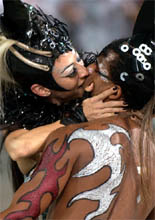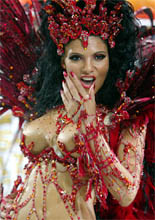

Once a pagan celebration in ancient Rome, Carnival in Rio de Janeiro is now considered one of the greatest shows on Earth. Rio is known as the cultural capital of Brazil and was the capital from 1822 to 1960, when it was moved to Brasilia. The first festivals of Rio date back to 1723.
Parade
The famous carnival parade has been going on since the 1930s. The parade goes on from Sunday evening into early morning Monday of the celebration. For a long time, the parade took place at Praca Onze and was later moved to Av. Presidente Vargas. It was in 1984 that the parade finally found its permanent home, the Sambadrome. The Sambadrome is a large structure that was built in the downtown area, which includes several buildings that make a circular fashion with a common open area in the middle. In the off season, buildings of the Sambadrome are used as classrooms for the local public schools.
Samba Schools
The carnival parade is filled with people and floats from various samba schools. A samba school can either be an actual school such as the Mocidade Padre Miguel or just a collaboration of local neighbors that want to attend carnival. Mocidade Padre Miguel is a performing arts school that was founded in 1955. It specializes in learning and excelling at Samba dancing and singing. The school joined in the competition of carnival in 1957, and finally won first place in 1979. Other samba schools include: Imperio Serrano, Academicos do Salgueiro, Unidos da Tijuca, and Beija-Flor de Nilopolis.
The purpose of carnival is for samba schools to compete with fellow rival schools, it is the climax of the whole carnival festival. Each school chooses a theme to try and portray in their entry. For example, when the Mocidade Padre Miguel school won first place in 1979, they had the theme of �Discoverer of Brazil.� The samba schools work to build the best floats and costumes to represent their themes, and to include the best music they can from their band called the bateria. There are many parts to each schools entry including the six to eight floats and thousands of participants.
There is a special order that every school has to follow with their parade entries. Each school beings with the abre-alas, which is the first wing. The abre-alas is made up of ten to fifteen people only, and they are the ones who introduce the school and set the mood. These people have choreographic dances in fancy costumes that usually tell a short story. Following the abre-alas is the first float of the samba school.
Some of the important roles include the porta-bandeira and mestre-sala. The porta-bandeira is a very important lady who is in charge of the samba school flag, including making sure to not allow the flag to roll. She is accompanied by the mestre-sala, who is supposed to draw everyone�s attention to �his queen,� the port-bandeira. Floatees, who are also important, are the people who populate the floats, also known as destaques. The floatees have the most luxurious and expensive costumes that can be extremely heavy. Along with all the floatees is one main floatee that is located at the top of each float. The main destaque dances and sings for the entire time that the float is on the runway.
One other aspect that is mandatory is the presence of the ala das baianas. This is a wing of the samba school entry that includes at least 100 females only. These women along with many other people do not ride on the floats as many others do, instead they are passistas, the people who belong to the samba school that do the marching along side and between the floats.
Balls
Besides the magnificent carnival parade, there are wonderful balls. Balls of every kind can be found in Rio including gala balls, balls for singles, and gay balls. The gala balls are the only luxury balls that are still around that can be enjoyed at the Copacabana Palace. Many different people attend the gala balls such as local socialites, soccer players, models, and international stars. The gala balls are a luxury event which requires black tie or fancy costumes. Besides the fancy gala balls are more casual and specific balls including the balls for singles and gays. Balls for singles are found at Copacabana Beach and a club called Scala. Gay balls are found at the Gala Gay at Scala and are open to everyone, especially for those with alternative lifestyles.
Street Carnival
As the parade is taking place in the Sambadrome and the balls are being held in the Copacabana Palace and beach, many of the carnival participants are at other locations. Street festivals are very common during carnival and are highly populated by the locals. Elegance and extravagance are usually left behind, but music and dancing are still extremely common. Anyone is allowed to participate in the street festivals. Bandas and bondos are very familiar with the street carnival especially because it takes nothing to join in on the fun expect to jump in. One of the most well known bandas of Rio is Banda de Ipanema. Banda de Ipanema was first created in 1965 and is known as Rio�s most irreverent street band.
Music and Dance
Incorporated into every aspect of carnival Rio are dancing and music. The most famous dance is the samba, an African dance brought over by the slaves. The samba was created by the African slaves mixing with the choros, street bands, of Brazil. The samba remains a popular dance not only in carnival but in the ghetto villages outside of the main cities. These villages keep alive the historical aspect of the dance without the influence of the western cultures. Other dances include the lundu, the polka, and the maxixe.
The samba is the main dance of Rio Carnival but it is not performed in silenct. Music is another major aspect of all parts of carnival. As stated by Samba City, �Samba Carnival Instruments are an important part of Brazil and the Rio de Janeiro Carnevale, sending out the irresistible beats and rhythms making the crowd explode in a colourful dance revolution fantasy fest!� The samba that is found in Rio is batucada, referring to the dance and music being based on percussion instruments. It �is born of a rhythmic necessity that it allows you to sing, to dance, and to parade at the same time.� This is why the batucada style is found in most all of Rio�s street carnivals.
Instruments of Carnival
Before the samba gained the percussive style, it was played with flutes and string instruments because percussion was looked upon as corrupt. It was in 1930 that the shift came to allow for percussion instruments. There is an ensemble of drum and percussion players that are lead by a man that plays an apito, a whistle used to control the music. The apito has three tones but is not very loud, so many leaders prefer to use referee whistles instead.
There are several types of drums within the ensemble including the surdos, caixas, repiniques, and tamborim. The surdo is a wide and deep drum that gives the bass drum foundation sound. The caixas is similar to the snare drum that gains it sound from the thin springs underneath the scin of the drum. Repiniques are just like the caixis except they do not have the sharp snare sound because they are missing the springs. Tamborims make similar sounds to the snare but are actually small cylinders covered with one tight skin. Not like any other of the drums is an instrument called the cuicas which is used to promote the melody. It creates is sound by rubbing a wet sponge alone a stick that is attached to the head of the drum on the inside. Accompanying the drums are shakers called chocalhos, made from metal, and ganzes, made from seeds enclosed in a cylinder. Little bells called agogos are used to promote the melody with two to five tones.
Festivities of carnival can be found throughout the world, but it cannot compare to carnival in Rio. With the combination of the parade, the balls, and the street carnivals, Rio�s carnival is said to be the greatest show on Earth. As the Rio de Janeiro handbook states, �The Rio carnival is probably the most famous party in the world.�
From Wikipedia, the free encyclopedia